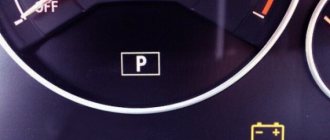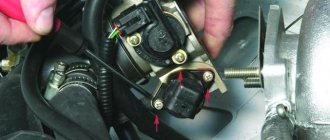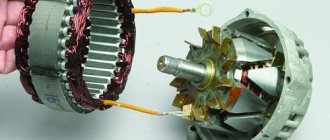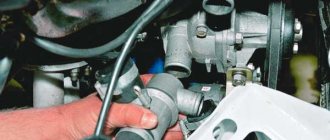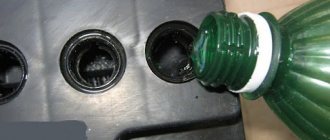Question "how to check a car battery“As a rule, it occurs in two cases: when purchasing a new battery or if some kind of malfunction is discovered in the battery already under the hood. The cause of the malfunction can be either undercharging or overcharging of the battery.
Undercharging occurs due to sulfation of the battery plates, which occurs during frequent trips over short distances, a faulty alternator voltage regulator relay, and turning on the warm-up.
Overcharging also occurs due to a faulty voltage regulator, only in this case it supplies too much voltage from the generator. As a result, the plates fall off, and if the battery is of a maintenance-free type, it may be subject to mechanical deformation.
How to check the battery yourself
So, how to check the performance of a car battery ?
Battery diagnostics - checking voltage, level and density.
Of all these methods, the most accessible to the average person is to use a tester to check the car battery and visually inspect it, and perhaps look inside (if the battery is serviceable) in order to see the color and electrolyte level. And to fully check the car battery for performance at home, you also need a densimeter and a load fork. Only in this way will the picture of the battery condition be as clear as possible.
Therefore, if there are no such devices, then the minimum actions that are available to everyone are to use a multimeter, a ruler and use regular consumers.
How to check the battery yourself
To test a battery without special equipment, you need to know its power (say, 60 Ampere/hour) and load it halfway with consumers. For example, by connecting several light bulbs in parallel. If after 5 minutes of operation they begin to glow dimly, it means the battery is not working as it should.
As you can see, such a home test is too primitive, so you can’t do without instructions on how to find out the real condition of a car battery. We will have to consider in detail the principles and all available testing methods, right down to measuring the density of the electrolyte and testing with a load simulating the operation of the starter.
General information
A multimeter allows you to find out the real voltage of the battery, and the readings will be as accurate as possible. In turn, by the voltage you will understand whether the car battery is charged or needs power.
By the way, you can use a multimeter to find out the voltage of phone chargers. Video on how to check 12V with a multimeter using the example of such a power supply:
This meter also allows you to detect current leakage. At the same time, it is important to check for leaks not only on the body, but also in the on-board vehicle network.
In general, checking the battery with a multimeter is possible by:
- capacity;
- resistance;
- current or amperage;
- charge (voltage).
Thanks to this range of measurements, you can minimize the likelihood of rapid battery discharge and increase its service life. And if, for example, you know how to check the starting current of a battery with a multimeter, then you will understand why the engine does not start.
In this useful article we will tell you about the most important things. Let's start with how to measure a battery's charge with a multimeter.
How to visually check the battery
Inspect the battery case for case cracks and electrolyte leaks. Cracks can occur in winter if the battery is poorly secured and has a fragile plastic case. When working on a battery, moisture, dirt, evaporation or electrolyte drips accumulate, which, together with oxidized terminals, contributes to self-discharge. You can check if you connect one voltage probe and run the second one along the surface of the battery. The device will show what self-discharge voltage is available on a particular battery.
Electrolyte leaks can be eliminated with an alkaline solution (a teaspoon of soda per glass of water). And the terminals are cleaned with sandpaper.
How to check the electrolyte level in a battery
The electrolyte level is checked only on those batteries that require servicing. To check it, you need to lower a glass tube (with marked divisions) into the battery filler hole. Having reached the separator mesh, you need to pinch the upper edge of the tube with your finger and pull it out. The electrolyte level in the tube will be equal to the level in the battery. The normal level is 10-12 mm above the battery plates.
Low electrolyte levels are often associated with “boiling over.” In this case, you just need to add water. Electrolyte is topped up only if there is confidence that it has somehow leaked out of the battery.
How to check the battery
Procedure for removing the battery from the car.
Before starting tests, you need to visually assess the condition of the power source. For example, a damaged housing can cause its failure.
For a better assessment, it is better to remove the battery from the socket. Disconnect the cables in the following sequence: first the ground terminal, that is, “minus”, then “plus”. To remove the battery, just unscrew the clamping mechanism. There is also a holding mechanism and this should be in working order as it prevents the battery from shaking.
The serviceability or malfunction of the battery can be determined by external signs. If bulges are visible on the side or on the cover, cracks, or damage to the terminals, the power supply has probably become obsolete. If it's just the cables, they're worn out or cracked, replacing them is much easier.
How to check battery electrolyte density
To measure the electrolyte density level, you will need a car hydrometer. You need to lower it into the battery filler hole and use a bulb to draw in such an amount of electrolyte so that the float dangles freely. Then look at the level on the hydrometer scale.
The peculiarity of this measurement is that the density of the electrolyte in the battery in winter and summer in some regions will be different depending on the season and the average daily temperature outside. The table presents the data that you should focus on.
| Season | Average monthly air temperature in January (depending on climatic region) | Fully charged battery | Battery is low | |
| by 25% | by 50% | |||
| -50°С…-30°С | Winter | 1,30 | 1,26 | 1,22 |
| Summer | 1,28 | 1,24 | 1,20 | |
| -30°С…-15°С | All year round | 1,28 | 1,24 | 1,20 |
| -15°С…+8°С | All year round | 1,28 | 1,24 | 1,20 |
| 0°С…+4°С | All year round | 1,23 | 1,19 | 1,15 |
| -15°С…+4°С | All year round | 1,23 | 1,19 | 1,15 |
How to test a car battery with a multimeter
To check the battery with a multimeter, you need to switch the latter to constant voltage measurement mode and set the range above the maximum voltage value for a charged battery. Next, you need to connect the black probe to the “minus” and the red one to the “plus” of the battery and look at the readings that the device gives.
The battery voltage should not be lower than 12 volts . If the voltage is lower, it means the battery is more than half discharged and needs to be charged.
Completely discharging the battery is fraught with sulfation of the plates.
Checking the battery with the engine running
To check the battery with the engine running, turn off all energy-consuming devices - stove, air conditioner, car radio, headlights, etc. The check is carried out as standard, as described above.
The indications of the multimeter readings when the battery is running are presented in the table below.
| Tester reading, Volt | What does it mean? |
| Low voltage, battery is not fully charged | |
| 13.5 — 14.2 | Normal indicators |
| > 14.2 | Increased tension. Typically indicates that the battery is discharged |
Low voltage indicates an undercharged battery. This is usually caused by a non-functioning/poorly functioning generator or oxidized contacts.
A voltage higher than normal most likely indicates a discharged battery (this often happens when the vehicle is idle for a long time, or during winter periods). As a rule, 10-15 minutes after recharging, the voltage returns to normal. If not, the problem is in the electrical equipment of the car, which threatens the electrolyte boiling.
How to check whether the battery is charged or not when the engine is not running?
When checking the battery with the engine off, the test with a multimeter is carried out in the same way as described above. All consumers must be switched off.
The readings are shown in the table.
| Tester reading, Volt | What does it mean? |
| 11.7 | The battery is almost completely discharged |
| 12.1 – 12.4 | The battery is about half charged |
| 12.5 – 13.2 | The battery is fully charged |
A little theoretical knowledge
Knowledge of how to test a car battery should also be combined with knowledge of normal values and readings and why they change.
The density of the electrolyte can change due to temperature fluctuations - overheating or hypothermia. In this case, in case of overheating, the electrolyte may boil, in which case the distilled water will partially boil away, and the electrolyte will become more dense.
In the case of cold, the electrolyte, on the contrary, often begins to have a reduced density. In both cases, the conductivity becomes worse, and therefore there are problems with the establishment, rapid “landing” and work on its last legs.
But why is any liquid so important? The thing is that the battery only looks like a small box. In fact, it consists of many parts, the main of which are conductive plates, positive and negative, which make up 6 elements connected in series. They are in contact with the electrolyte, so the electrical impulses move with the necessary force.
For what other reasons could a battery suddenly stop working? For example, just from time to time. On average, batteries work stably for 3–4 years. Of course, many work longer, but their capacity and ability to hold a charge still decreases.
Another reason is frequent battery overcharging, undercharging, or complete discharge. It is very important for a car battery to maintain some kind of average state, without strong changes.
The next reason is hidden in the generator, or rather, in its breakdown. In this case, it may either constantly recharge the battery, giving too much current, or, conversely, may not even be able to maintain the existing charge. Both options indicate the need for urgent replacement of the generator.
The last on the list of unpleasant situations is current leakage: something in the car consumes too much energy even when the car is turned off and parked. This can be determined using the same multimeter. To do this, you will need to turn off the car and remove the negative terminal of the car from the battery. Turn the multimeter into current measurement mode, set the switch to 10 or 20 units. Connect one wire to the negative terminal of the car, and the other to the negative terminal of the battery.
If the readings are other than zero, it is necessary to remove and insert all fuses and relays one by one. The readings will definitely be given by the node that drains the battery.
Checking with a load fork
A load plug is a device that represents some kind of electrical load (usually a high-resistance resistor or a refractory coil) with two wires and terminals for connecting the device to the battery, as well as a voltmeter for taking voltage readings.
The verification process is quite simple. It consists of the following steps:
- You need to work at a temperature of +20°С…+25°С (in extreme cases up to +15°С). You cannot test a cold battery , as you risk significantly discharging it.
- The plug is connected to the battery terminals - the red wire is to the positive terminal, and the black wire is to the negative terminal.
- Using the device, a load with a current of 100...200 Amperes is created (this is an imitation of a switched on starter ).
- The load acts on the battery for 5...6 seconds.
Based on the readings of the ammeter and voltmeter, we can talk about the condition of the battery.
| Voltmeter readings, V | Charge percentage, % |
| >10,2 | 100 |
| 9,6 | 75 |
| 9 | 50 |
| 8,4 | 25 |
| 0 |
On a fully charged battery, after applying a load, the voltage should not drop below 10.2 V. If the battery is slightly discharged, then a drop of up to 9 V is allowed (however, in this case it must be charged). And after this, the voltage should be restored almost immediately , and after a few seconds completely.
Sometimes it happens that if the voltage is not restored, then there is a high probability of one of the banks shorting. For example, with minimal load it is necessary for the voltage to recover to 12.4 V (up to 12 V is allowed with a slightly discharged battery). Accordingly, the lower the voltage drops from 10.2 V, the worse the condition of the battery. With this device you can check the battery both upon purchase and already installed in the car, without removing it.
External inspection of the battery
You met the seller and have already walked around the car, seeing how clean and beautiful it is. It's time to look under the hood, you lift the lid and see the usual contents of the engine compartment, the engine and numerous systems that keep the car running.
In most cases, here, in the engine compartment, there is also a battery - a rectangular box with electrolyte inside, to which two wires are connected - positive and negative. These wires go to the distribution block, and from this massive electrolytic “battery” the entire machine and all its systems are powered with electricity.
Even if you don’t understand anything about cars and went for an independent inspection rather as part of a formality, you can still determine by the appearance of the battery what condition it is in.
During an external inspection, attention should be paid mostly to the integrity of the elements, and whether the battery itself and contacts are clean. There are a number of external factors, the presence of which immediately indicates the need to replace or at least clean the battery.
- Dirt on contacts. In order for the battery to work, both contacts connected to it by wiring must be clean. If the contacts are dirty, this indicates that the battery is not new, and dirt will interfere with the correct operation of the contacts.
- Oxidation of the terminals - foreign deposits can be seen on the battery terminals with the naked eye - this is oxidation, which in most cases is associated with electrolyte leakage. Electrolyte is an acid that is found inside the battery. If it spills and gets on the contacts, it can lead to poor battery performance and a reduction in the contact area.
- Cracks on the case - the battery itself should be intact. The plastic box containing the electrolyte must not be damaged. This is also clearly visible without additional equipment and in good lighting.
- Dirt, dust, electrolyte leaks - all this is removed with a rag, and the car should not be allowed to drive with a dirty battery, since the conductive deposit will contribute to its rapid discharge and deterioration of performance.
In addition to the external inspection, you can start the car engine. A cold start will be especially indicative if the engine has not been started for a long time and it is cold outside. If the car starts easily, the battery is in order, but if it does not start or starts with difficulty, the headlights shine dimly, and the instrument panel is also not brightly lit, then the battery should be changed. Or, at least, check it with instruments, which we will discuss below.
How to test a new battery?
Checking a car battery before purchasing is a very important procedure. Firstly, when using a low-quality battery, defects often appear only after a certain time, which makes it impossible to replace the battery under warranty. Secondly, even if a counterfeit is detected in a timely manner, the warranty replacement procedure can be quite lengthy (inspection and evaluation of the product by specialists, etc.).
Therefore, in order to avoid problems, before purchasing, you can use a simple verification algorithm, which will protect you by 99% from purchasing low-quality batteries:
- Visual inspection . You also need to look at the production date. If the battery is more than 2 years old, it is better not to buy it.
- Measuring the voltage at the terminals using a multimeter . The voltage on the new battery must be at least 12.6 Volts.
- Checking the battery using a load fork . Sometimes the sellers themselves offer to do this procedure; if not, then it is advisable to ask to check the performance of the car battery with a load fork yourself.
How to check if the battery is alive in a car without instruments?
Battery indicator
It is quite easy to determine the condition of the battery in a car without special instruments. There are several ways to do this.
Modern batteries have a special charge indicator, usually in the form of a round window. You can determine the charge by the color of this indicator. Next to such an indicator on the battery there is always a decoding indicating which color corresponds to a particular charge level. Green - full charge; gray - half charge; red or black - full discharge.
In the absence of such an indicator, you can use two methods. The first is using headlights. The cooled engine is started and the low beam is turned on. If the light does not dim during 5 minutes of operation, then everything is normal.
The second (also when cold) is to turn on the ignition, wait a minute, and then press the signal several times. With a “live” battery, the beep sound will be loud and continuous.
My time has come
How long should a battery last? My record from the Zhiguli era is nine years. The service life of modern batteries in current conditions largely depends on the nature of travel, weather conditions and the condition of the car, but the average is known: 4–5 years. Is your battery this age? Then get ready for replacement. There is another way to predict the future of the battery: you need to focus on the mileage of the car. On average, according to observations of the cars of the editorial fleet, it is about 100,000 km. And if, moreover, winter is ahead, then a replacement will be justified.
How to care for your battery
To ensure that the battery lasts longer and does not fail prematurely, it should be maintained regularly. To do this, the battery and its terminals must be kept clean and discharged/charged during prolonged inactivity. In severe frosts, it is better to take the battery from under the hood to a warmer place. Some manufacturers recommend charging the battery once every 1-2 weeks, arguing that sometimes the consumption exceeds the self-charging of the battery. Thus, checking the battery is a completely feasible task and necessary for the proper operation of the car.
Why use a multimeter to check the battery?
A multimeter is an indispensable thing if you are a car owner. After all, situations are different, you may urgently need to measure the battery charge, and the nearest service station is tens of kilometers away. And why spend money on measuring the charge at a service station every time, if you can buy a multimeter once and forget about the problems.
For example, the following situation arose. Your car has been sitting in the garage for a long time with the battery terminal disconnected, and suddenly there is a need to go somewhere and it is unclear what and how the battery is charged, even if the engine starts without problems. In such a situation, you just need to take a multimeter and measure the battery voltage with it. If this is not done, then a low charge level on the road can be a fatal mistake. The density of the electrolyte will drop due to “undercharging”, and in cold weather the battery will simply freeze, or its slow destruction will occur.
At the same time, it is not necessary to buy an expensive device; even the most budget option will cope with the task.


